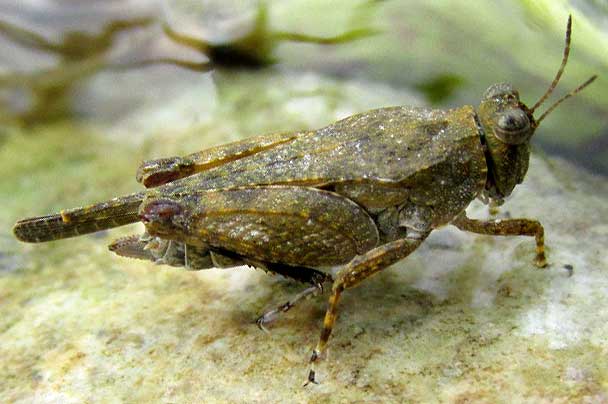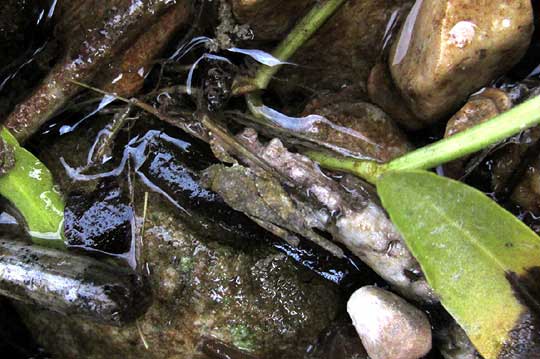Excerpts from Jim Conrad's
Naturalist Newsletter

from the July 27, 2014 Newsletter issued from the Frio Canyon Nature Education Center in the valley of the Dry Frio River in northern Uvalde County, southwestern Texas, on the southern border of the Edwards Plateau; elevation ~1750m (~5750 ft); N29.62°, W99.86°; USA
AZTEC PYGMY GRASSHOPPER
In mud among limestone cobbles where the Dry Frio's meager current was just lively enough to make a little trickling sound, something almost too small to bother with jumped out the way when I shifted my foot. In fact, I did ignore it awhile, until it dawned on my heat-numbed brain that this might be worth looking at. However, on hands and knees, I couldn't find it exactly where I'd seen it land. I've known interesting species with amazing camouflage abilities, so I focused the camera on the spot where I'd seen it land, and got the shot shown below.

If you don't see it, our quarry sits right in the picture's center, in full view. After taking that picture I waved a hand over the area hoping to scare whatever it was into moving, and it did, right onto an alga covered cobblestone where it revealed itself, to my astonishment, to be a dwarf grasshopper looking extraordinarily like a toad. Its compound eyes, instead of being mounted along the head's side, had shifted to the head's very top, looking like a toad's poison-secreting glands, the parotoid glands. Also, the femurs of its hind legs were thick and shaped just like a toad's, and the entire grasshopper was warty-textured and colored like a toad. At the top of this page you can see the whole thing -- the body being only about half an inch long (12mm).
Volunteer identifier Bea in Ontario had fun figuring out that our toad-grasshopper was a member of the Pygmy Grasshopper Family, the Tetrigidae, of which worldwide about 1,600 species have been described in some 250 genera. She even got it genus level, Paratettix. Grasshoppers in the Pygmy Grasshopper Family are recognized not only by their small size but also from the saddle-like scale immediately behind their heads (the pronotum), which extends backward over the abdomen, sometimes reaching the wing tips. Most grasshopper pronotums are only a little wider that the grasshopper's head. Our grasshopper's pronotum doesn't reach its wing tips, but it almost does.
Many pygmy grasshoppers are famous for their camouflage coloration and patterning, and most species occur along streams and ponds, where they feed on algae and diatoms, so our Dry Frio species fits into the family nicely.
Bea having done the hard work of figuring out the genus, Paratettix, I set about trying to narrow it down to species level. BugGuide.Net lists eight Paratettix species for North America. After doing image searches for each name, and basing my identification on our grasshopper's compound eyes being so completely atop its head, plus the shape of the short ovipositor at the tip of her abdomen, and its general color, I'm thinking we have the Aztec Pygmy Grasshopper, PARATETTIX AZTECUS, which occurs through most of Central America and Mexico, and extends into the US mainly in the southwestern states.
I read that between 80% and 100% of our Aztec Pygmy Grasshopper's diet consists of "aquatic primary production," which I assume to be the algae and diatoms mentioned as the prime food of most pygmy grasshoppers. Also I read that members of this family living along streams, like ours, are capable of swimming on the water's surface, and they readily leap into water when alarmed.
Who'd have thought that grasshoppers could do such things? And to think that I almost didn't even look closer just because it was so hot and I was tired.